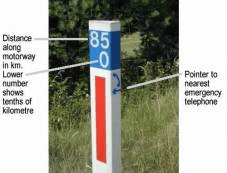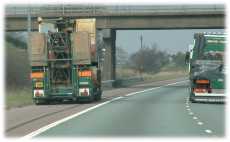After you have finished your Driving Lessons in Newcastle and have passed your driving test in Newcastle, that’s when you REALLY learn to drive, and one thing you don’t get taught is about Motorway Breakdowns!
If you break down, move to the hard-shoulder and switch on your hazard warning lights.
If you can’t get to the hard shoulder because your car is damaged or stops and won’t restart, switch on your hazard warning lights and get well clear to stand in a safe position. If your battery is good it can also help to leave sidelights on – especially in poor weather conditions.
If you carry a red warning LEAVE IT IN THE BOOT. Although reflective triangles can be particularly effective at night, especially on narrow roads or fast A-roads they can cause problems on motorways.
The old safety advice was to place your triangle 150 metres behind your vehicle; however, it is now considered that the risks of walking to place and retrieve the triangle outweigh the benefits.
Other dangers are that the triangle can be blown into the road with the turbulence cause by large fast vehicles or knocked into the path of moving traffic causing further danger or accidents.
Try to warn other drivers if possible (by waving etc.) but do not stand on the main carriageway or try to stop drivers by running in front of them.
Use the nearside door to get out of your vehicle. If you have passengers with you get them out of the vehicle to place of safety such as the grass verge behind the hard shoulder. Wear hi-viz vests for added safety.
If you have any animals or pets with you leave them in the vehicle or ensure that they are securely held on a leash or appropriate restraint.
Marker post 
Inform the emergency services as soon as possible that you have broken down. Marker posts on the side of the road will direct to the nearest phone (never cross to a telephone on the opposite carriageway!). All the phones are numbered and connect directly to the police control centre. If you use your mobile phone to contact the authorities the marker posts at the side of the hard shoulder will be numbered – this will help the authorities to locate you.
It is not generally a good idea to try and repair your vehicle yourself on the hard shoulder. The high speed of traffic rushing by makes this a very dangerous environment.
Even if you only need to change a wheel wait until there is a a police or Highways Agency vehicle parked behind you to shield you from the traffic and to draw attention to your presence.
While you’re waiting for the emergency services to arrive sit on the grass verge, well away from the traffic whenever possible – statistics about collisions on the hard-shoulder suggest that you will be safer there than sitting in your car. If you are disabled and unable to safely get out of your vehicle or have no mobile phone with you, switch on your hazard warning lights, display a ‘HELP’ pennant and wait for help to arrive.
Breakdown 
If you see other vehicles broken down on the hard shoulder, give them a wide berth. The truck driver in the photo on the right moved out, probably because he was aware that the driver of the broken down truck could walk around the front, or that the truck could start moving.
Finally, when rejoining the main carriageway after a breakdown or emergency, build up your speed on the hard shoulder (in the same way that you would joining the motorway from an acceleration lane) and then merge with the traffic in lane-one.
